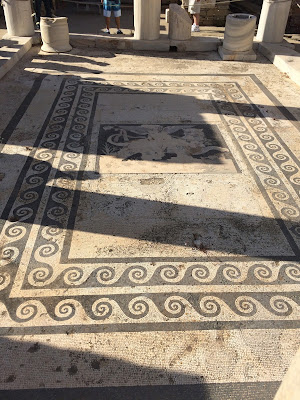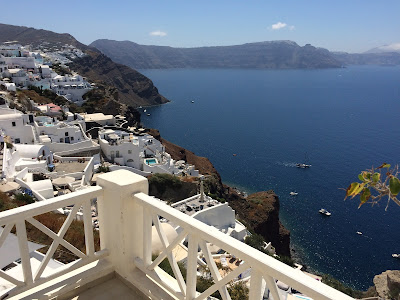My wife and I have been greatly blessed in so many aspects of our lives. One of those great blessings has been the opportunities we have had to travel and see other countries, meet fascinating people, and explore their cultures. One of our amazing trips in recent times was to the Greek Isles.
Greece has always been someplace that I thought would be interesting, but honestly it wasn't as high on my list of places to visit as some others; however, after having visited the beautiful country, exploring the fascinating antiquities and ruins, and meeting some amazing people living there, I am most appreciative of having been afforded such a wonderful experience.
One of the first places we journeyed to was to a small island named Delos. This island is reachable by a short boat trip from the bigger island of Mykonos. Delos was considered the birth place of the twin gods Apollo and Artemis by the ancient Greeks, and today is recognized as a UNESCO World Heritage Site. Delos is an archeological, historical, and mythological gem. The ancient ruins scattered on this small island are amazing in their breadth and scope, as archeological excavations still occur today to unearth forgotten treasures.
This area is the entrance to the courtyard of a home that was likely owned by a wealthy merchant and is named the House of Dionysus. The ancient Greeks of means would typically have an open courtyard with various living and sleeping quarters built around the perimeter thereof.
Here is an intricate picture made entirely of thousands of small little tiles to form this beautiful mosaic that adorned the courtyard of this home. It depicts the god Dionysus riding a tiger, and hence the naming of this home. The artistry involved with this mosaic was truly amazing! The original mosaic (bottom of the two preceding pictures) was carefully removed and displayed in the museum on Delos. The other picture is a recreation in the courtyard.
These are the columns in the courtyard of the House of Dionysus that would have supported the roof that covered the rest of the home while being open to the sky in the middle of the courtyard.
This is a typical example of the walkway between homes that one would see in this ancient town.
And of course, what Greek town would be complete without a theater? Considering how many millennia have passed since it's construction, it is still in remarkably good shape.
This is a picture from the market area of the ancient town. If you look carefully, you can see the stairs created going up the mountain for the ancient Greeks to climb to worship Zeus.
These are replicas of what archeologists suspect were nine to twelve lions that guarded the road of the "Sacred Way" as early as 600 BC. What remains of the actual lions has been placed in a small museum on the island as pictured below.
This is a statue of the Greek god Artemis killing a deer. Artemis, the twin sister of the god Apollo, was the goddess of the hunt. This statue was found in the theater quarter and dates back to the 2nd century B.C. The Romans referred to Artemis as Diana. This statue also resides in the museum on Delos along with myriads of other beautiful artifacts discovered there.
This is looking from the Sacred Way guarded by the lions looking out towards the bay on Delos.
Our next stop was at the beautiful town of Mykonos. This is the view from our boat as we entered the town and tied up to the pier. All of the buildings are painted white to reflect the heat of the Aegean sun.
These are some of the windmills that can be seen from the bay on the outskirts of the town. Mykonos is known as the island of the winds and these windmills were constructed to take advantage of that long ago.
The three preceding pictures are of some of the homes and neat little shops along the foot paths of the town of Mykonos. There are no cars within most of the town and you can only get to where you are going by walking these charming little meandering paths through town. The bougainvillea was in bloom in brilliant magenta hues, adding to the charm of the town. Mykonos is well-known for its very vibrant night life and the people there definitely know how to party.
Next on our adventure was a trip to Santorini. The towns on this beautiful island are all built around the top of the cliffs of a massive extinct volcanic caldera that then collapsed and was consumed by the azure waters of the sea. The picture above is one of the bigger churches at the town of Oia.
One can see the cliffs to the ocean below and other parts of the rim of the caldera in the distance.
This picture was taken from the balcony of the restaurant where my wife and I ate a delicious lamb lunch. Any of the buildings you see with blue-painted domes are chapels.
Our last stop on our Greek adventure was to the capital of Athens. The city is huge, and unfortunately due to socialist practices for decades, the economy is in horrible shape. Many countries in the EU have had to bail out Greece, and Athens in particular because of this. As a result, there is very high crime and much vandalism everywhere of what was once the cradle of Western civilization. Nowadays, as one drives through the city, the disrepair and graffiti, even on historic beautiful buildings is readily apparent. This is a town where you must definitely be on alert for trouble.
All of that said, we did see the obligatory site of the Parthenon. This amphitheater above is on the path up the hill to the Parthenon. It is still used today for some events. The Greek-American composer Yanni has done concerts at this location for example.
And as you enter the temple grounds, this is the first view of the Parthenon that you encounter.
"The Parthenon, dedicated by the Athenians to Athena Parthenos, the
patron of their city, is the most magnificent creation of Athenian
democracy at the height of its power. It is also the finest monument on
the Acropolis in terms of both conception and execution. Built between
447 and 438 BC, as part of the greater Periklean building project, this
so-called Periklean Parthenon (Parthenon III) replaced an earlier marble
temple (Parthenon II), begun after the victory at the battle of
Marathon at approximately 490 BC and destroyed by the Persians in 480
BC. This temple had replaced the very first Parthenon (Parthenon I) of
c. 570 BC. The Periklean Parthenon was designed by architects Iktinos
and Kallikrates, while the sculptor Pheidias supervised the entire
building program and conceived the temple's sculptural decoration and
chryselephantine statue of Athena." ~ http://odysseus.culture.gr
This is the view of the Parthenon from the other end of it that was not under renovation.
This second temple on the Acropolis is called the Erechteion and was a multipurpose temple with a variety of sacred places
and cults, including sanctuaries to Poseidon, Erechtheus, and Athena
Polias. It was built in 405 BC.
This is a close up of the statues that serve as columns on the Erechteion.
The entrance to the Erechteion was impressive in its scale.
Our trip to Greece proved to be a a wonderful adventure and far exceeded my initial expectations. Other than in Athens, the people were friendly, the food was delicious, and the thought of enjoying a cold adult beverage in the shade of a restaurant balcony overlooking the beautiful Aegean Sea has me thinking that perhaps I may indeed wish to return to Greece yet again in my future travels, God willing!
It is definitely worth seeing, if you are ever afforded the opportunity to travel there! Safe voyage to you!



















 .
.







